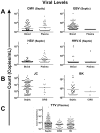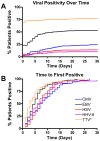Reactivation of multiple viruses in patients with sepsis
- PMID: 24919177
- PMCID: PMC4053360
- DOI: 10.1371/journal.pone.0098819
Reactivation of multiple viruses in patients with sepsis
Abstract
A current controversy is whether patients with sepsis progress to an immunosuppressed state. We hypothesized that reactivation of latent viruses occurred with prolonged sepsis thereby providing evidence of clinically-relevant immunosuppression and potentially providing a means to serially-monitor patients' immune status. Secondly, if viral loads are markedly elevated, they may contribute to morbidity and mortality. This study determined if reactivation of herpesviruses, polyomaviruses, and the anellovirus TTV occurred in sepsis and correlated with severity. Serial whole blood and plasma samples from 560 critically-ill septic, 161 critically-ill non-septic, and 164 healthy age-matched patients were analyzed by quantitative-polymerase-chain-reaction for cytomegalovirus (CMV), Epstein-Barr (EBV), herpes-simplex (HSV), human herpes virus-6 (HHV-6), and TTV. Polyomaviruses BK and JC were quantitated in urine. Detectable virus was analyzed with respect to secondary fungal and opportunistic bacterial infections, ICU duration, severity of illness, and survival. Patients with protracted sepsis had markedly increased frequency of detectable virus. Cumulative viral DNA detection rates in blood were: CMV (24.2%), EBV (53.2%), HSV (14.1%), HHV-6 (10.4%), and TTV (77.5%). 42.7% of septic patients had presence of two or more viruses. The 50% detection rate for herpesviruses was 5-8 days after sepsis onset. A small subgroup of septic patients had markedly elevated viral loads (>104-106 DNA copies/ml blood) for CMV, EBV, and HSV. Excluding TTV, DNAemia was uncommon in critically-ill non-septic patients and in age-matched healthy controls. Compared to septic patients without DNAemia, septic patients with viremia had increased fungal and opportunistic bacterial infections. Patients with detectable CMV in plasma had higher 90-day mortality compared to CMV-negative patients; p<0.05. Reactivation of latent viruses is common with prolonged sepsis, with frequencies similar to those occurring in transplant patients on immunosuppressive therapy and consistent with development of an immunosuppressive state. Whether reactivated latent viruses contribute to morbidity and mortality in sepsis remains unknown.
Conflict of interest statement
Figures








References
-
- Angus DC, van der Poll T (2013) Severe sepsis and septic shock. N Engl J Med 369: 840–851. - PubMed
-
- Munford RS, Pugin J (2001) Normal responses to injury prevent systemic inflammation and can be immunosuppressive. Am J Respir Crit Care Med 163: 316–321. - PubMed
-
- Hotchkiss RS, Karl IE (2003) The pathophysiology and treatment of sepsis. N Engl J Med 348: 138–150. - PubMed
-
- Cohen J, Opal S, Calandra T (2012) Sepsis studies need new direction. Lancet Infect Dis 12: 503–505. - PubMed
Publication types
MeSH terms
Grants and funding
LinkOut - more resources
Full Text Sources
Other Literature Sources
Medical

